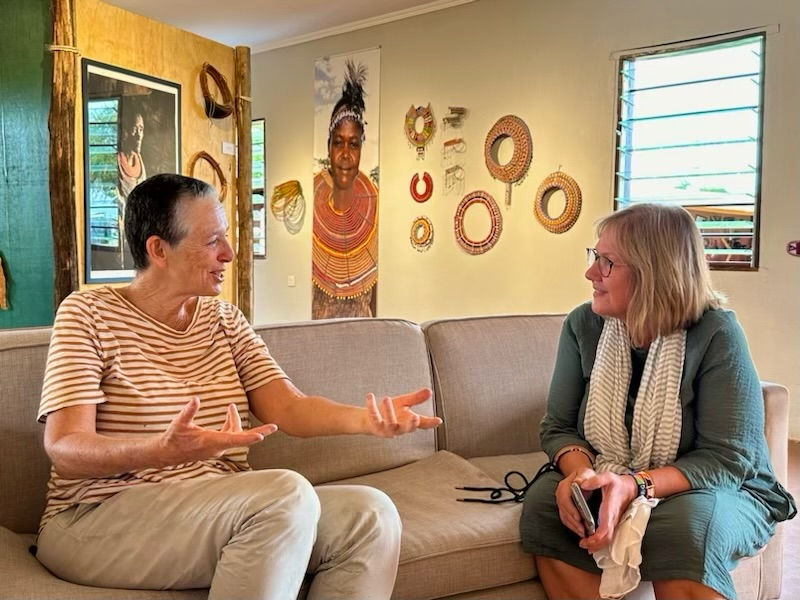Culture, Education and Business Combine at The Beads Museum
- Matt Hund

- Oct 23
- 4 min read

We at the Uplift Travel Foundation are proud to stand alongside community leaders and activists working to address the locally identified needs of rural Kenya, and we’re humbled by the good works we have become part of through involvement with local visionaries in our key areas of impact.
Among them:
Featured Partner: Eti Dayan, The Beads Museum
We came to know Eti Dayan through her compelling book, “One of Them — My Life Among the
Maasai of Kenya.” It’s a must-read for any traveler to the country, and tells the story of a tour guide who chooses to live a traditional Maasai lifestyle and what she discovers about the culture (and herself) along the way. You can find her book here.
Eti became a featured partner of the Uplift Travel Foundation through another inspiring project: The Beads Museum, part of a nonprofit women’s empowerment center located at the Sekenani Gate of the Maasai Mara National Reserve. A visit to the museum is full of cultural significance and support for the individual jewelry makers and artisans helping preserve the knowledge and craftsmanship that came before. Basically, it is where culture, education and business combine.
To learn more, read the Q&A with Eti below and remember! Donations of even $10 help provide beads and other materials for Maasai artisans to craft jewelry and other items to sell as local and small business entrepreneurs. If you’d like to donate, visit UpliftTravel.org/Donate.
In Their Own Words: Q&A with Eti Dayan

You didn’t just capture Maasai culture in your writing, you also co-founded a museum dedicated to East African bead heritage. What inspired this?
For many years as a tour guide, I traveled and spent time among many East African ethnic groups. I witnessed firsthand how development (especially new roads) brought change and modernization — in short, people began abandoning their old ways of life for modern alternatives. Clothing was one of the first things to change. People stopped making traditional hide garments and instead began buying cheap, colorful fabrics in the newly opened markets. I could literally see unique and beautiful fashion disappearing, and the same was happening with jewelry. Traditional designs being replaced by modern ones is fine, but it’s also important to understand beading is more than simply decoration: It’s one of the most meaningful ways of expressing personal and social identity.
How has the museum evolved in terms of what you hope to achieve?
The shift from traditional to modern beadwork among East African peoples is inevitable. For me, the disappearance of this heritage and ethnic identity it expresses is a great loss. The museum, which is unique in Africa, serves as a reminder not only of the beauty of beaded art, but also of a culture that is rapidly vanishing.
The museum is part of a women’s empowerment center. Can you share more about your shared vision?
Beading has always been a traditional activity of Maasai women. In the past, they created bead work for their families. Today, they make items for tourists to earn income. Until recently, the only way they knew to sell it was by rushing toward passing tourist vehicles — we wanted to change that. Although progress is slow, we are seeing results as we invite artisans to our beautiful facility, provide them with quality materials, teach new techniques and styles, give them beading assignments and pay them for their work at the end of the day.
What is the relationship between empowerment and the museum?
Our vision goes beyond empowering individual artisans: We aim to show the community how hard work pays — and that we can exist without relying permanently on external funding (even though we still welcome donations). The museum fits perfectly into this vision by attracting tourists, school groups and locals alike. Revenue from entry, souvenirs and the cafeteria allow us to sustain our work.
What does buying a pair of earrings (or several) do for this community?
It’s simple: While we provide the materials, each pair of earrings you buy in our shop was handmade by a Maasai artisan who received payment equivalent to about one kilogram of maize flour. In a single day, they can create three or four pairs, so the revenue supports not only our operational costs but also a livelihood — as well as community initiatives.

How can visitors interact with you and others at the museum?
Karibu! You are very welcome to visit our museum. We offer a variety of activities within our facility. One of the highlights is a bracelet beading workshop with Maasai artisans — a wonderful opportunity for personal interaction and cultural exchange. Visitors can also talk with our museum guides and hear their own inspiring stories. As for me, I’m almost always around, and I would be delighted to meet and chat with you personally.
Subscribe to our newsletter to learn more about the Uplift Travel Foundation and our wonderful in-country partners and projects. Learn more about both our areas of impact and how to travel with us at UpliftTravel.org.




Comments